|
The Building: Exterior 
Carol Highsmith
Architect Henry Bacon modeled the Lincoln Memorial after the Parthenon in Athens, Greece. Bacon felt that a memorial dedicated to a man who defended democracy should echo the birthplace of democracy. The towering memorial is 190 feet long, 120 feet wide, 99 feet tall and constructed with Colorado Yule marble.
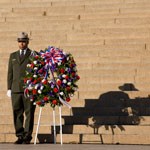
The Lincoln Steps and Plaza
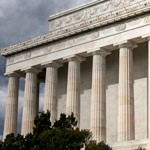
ColumnsThe memorial is surrounded by 36 fluted Doric columns, one for each of the 36 states in the Union at the time of Lincoln's death. When you walk up the steps, two additional columns are located at the entrance behind the colonnade. These columns are 44 feet tall with a base diameter of seven feet and five inches. Each column is composed of 12 individual drums. The columns, like the exterior walls and facades, are inclined slightly inward. This is to compensate for perspective distortions which would otherwise make the memorial appear asymmetrical.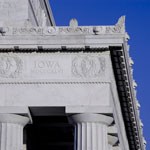
Frieze and Cornice

The Lincoln Memorial interior is divided into three chambers (north, south, and central). Two rows of four Ionic columns separate the chambers. Gaze up at these 50 foot high columns. Wrap your arms around their five foot six inch diameter bases. The columns support the memorial ceiling, towering 60 feet above the floor. The glowing ceiling is framed by bronze girders, ornamented with laurel and oak leaves. Between the girders are panels of Alabama marble, saturated with paraffin to increase their translucency. Together these larger than life elements envelop the larger than life statue of Abraham Lincoln to create an atmosphere of quiet reflection and awe.

The Inscriptions
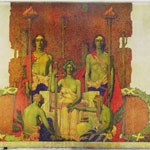
The Murals: 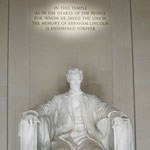
The Statue
The Memorial Landscape 
Carol Highsmith Photo. 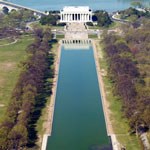
Reflecting Pool and Elm Walks 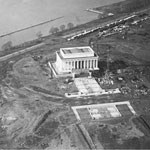
USNavy Photo While the Lincoln Memorial today looks as though it was always meant to be where it stands, the landscape of the Lincoln Memorial and surrounding grounds required decades of planning and earth-moving. Through six key periods of construction, the memorial and its surrounding landscape took shape out of the wetlands and mudflats of the Potomac River. 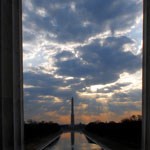
NPSVIP Dan Arandt Views and Vistas |
Last updated: May 18, 2021
